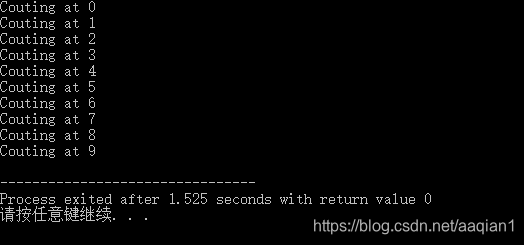1、什么是对象数组?
https://blog.csdn.net/aaqian1/article/details/84061049
2、什么是 this 指针?它的主要作用是什么?
https://blog.csdn.net/aaqian1/article/details/84137285
3、友元函数有什么作用?
https://blog.csdn.net/aaqian1/article/details/84427884
友元函数不是当前类的成员函数,而是独立于当前类的外部函数,但它可以访问该类所有的成员,包括私有成员、保护成员和公有成员。
当一个函数需要访问多个类时,友元函数非常有用,普通的成员函数只能访问其所属的类,但是多个类的友元函数能够访问相应的所有类的数据。此外,在某些情况,例如运算符被重载时,需要用到友元函数。
4、假设在程序中已经声明了类 point ,并建立了其对象 p1 和 p4 。那么 “p4=p1” 是什么意思?
将对象 p1 数据成员的值拷贝到对象 p4 中,这个过程是通过默认赋值运算符函数实现的。
对象的赋值指对其中的数据成员赋值,而不对成员函数赋值。两个对象之间的赋值,仅仅使这些对象中的数据成员相同,而两个对象仍是分离的。
5、在声明类时,正确的是( )。
A. 可以在类的声明中给数据成员赋初值。
B. 数据成员的数据类型可以是 register。
C. private、public、protected 可以按任意顺序出现。
D. 没有用 private、public、protected 定义的数据成员是公有成员。
答:选 C。可以参考:https://blog.csdn.net/aaqian1/article/details/83795185
6、下面有关静态成员函数的描述中,正确的是( )。
A. 在静态成员函数中可以使用 this 指针。
B. 在建立对象前,就可以为静态数据成员赋值。
C. 静态成员函数在类外定义时,要用 static 前缀。
D. 静态成员函数只能在类外定义。
答:选B。可以参考:https://blog.csdn.net/aaqian1/article/details/84329893
7、在下面有关友元函数的描述中,正确的说法是( )。
A. 友元函数是独立于当前类的外部函数。
B. 一个友元函数不能同时定义为两个类的友元函数。
C. 友元函数必须在类的外部定义。
D. 在外部定义友元函数时,必须加关键字 friend。
答:选 A。https://blog.csdn.net/aaqian1/article/details/84427884
8、友元的作用之一是( )。
A. 提高程序的运行效率。
B. 加强类的封装性。
C. 实现数据的隐藏性。
D. 增加成员函数的种类。
答:选 A。https://blog.csdn.net/aaqian1/article/details/84427884
9、以下程序用到的知识是
(1)参考:https://blog.csdn.net/aaqian1/article/details/84494415
#include<iostream>
using namespace std;
class B{
private:
int x,y;
public:
B(){}
B(int i,int j){
x=i;
y=j;
}
void printb(){
cout<<x<<","<<y<<endl;
}
};
class A{
private:
B c;
public:
A(){}
A(int i,int j);
void printa();
};
A::A(int i,int j):c(i,j){}
void A::printa(){
c.printb();
}
int main(){
A a(7,8);
a.printa();
return 0;
}
(2)同上
#include<iostream>
using namespace std;
class A{
private:
int x,y;
public:
void set(int i,int j){
x=i;
y=j;
}
int get_y(){
return y;
}
};
class Box{
private:
int length,width;
A lable;
public:
void set(int l,int w,int s,int p){
length=l;
width=w;
lable.set(s,p);
}
int get_area(){
return length*width;
}
};
int main(){
Box b;
b.set(4,6,1,20);
cout<<b.get_area()<<endl;
return 0;
}
(3)参考:https://blog.csdn.net/aaqian1/article/details/84502579
#include<iostream>
using namespace std;
class Sample{
private:
int x,y;
public:
Sample(int i,int j){
x=i;
y=j;
}
void disp(){
cout<<"disp1"<<endl;
}
void disp() const{
cout<<"disp2"<<endl;
}
};
int main(){
const Sample a(1,2); //常对象
a.disp();
return 0;
}
(4)同上
#include<iostream>
using namespace std;
class R{
private:
int R1,R2;
public:
R(int r1,int r2){
R1=r1;
R2=r2;
}
void print();
void print() const;
};
void R::print(){
cout<<R1<<","<<R2<<endl;
}
void R::print() const{
cout<<R1<<","<<R2<<endl;
}
int main(){
R a(6,8);
a.print();
const R b(56,58);
b.print();
return 0;
}
(5)参考:https://blog.csdn.net/aaqian1/article/details/84061049
#include<iostream>
using namespace std;
class Toy{
private:
int quan,price;
public:
Toy(int q,int p){
quan=q;
price=p;
}
int get_quan(){
return quan;
}
int get_price(){
return price;
}
};
int main(){
Toy op[3][2]={
Toy(10,20),Toy(30,40),
Toy(50,60),Toy(70,80),
Toy(90,100),Toy(110,120)
};
for(int i=0;i<3;i++){
cout<<op[i][0].get_quan()<<",";
cout<<op[i][0].get_price()<<"\n";
cout<<op[i][1].get_quan()<<",";
cout<<op[i][1].get_price()<<"\n";
}
return 0;
}
(6)参考: https://blog.csdn.net/aaqian1/article/details/84146224
#include<iostream>
using namespace std;
class Example{
private:
int i;
public:
Example(int n){
i=n;
cout<<"Constructing\n";
}
~Example(){
cout<<"Destructing\n";
}
int get_i(){
return i;
}
};
int sqr_it(Example o){
return o.get_i()*o.get_i();
}
int main(){
Example x(10);
cout<<x.get_i()<<endl;
cout<<sqr_it(x)<<endl;
return 0;
}
执行结果:

(7)参考:
https://blog.csdn.net/aaqian1/article/details/84329893
https://blog.csdn.net/aaqian1/article/details/83717529
#include<iostream>
using namespace std;
class A{
private:
static int total;
public:
A(){
total++;
}
~A(){
total--;
}
int gettotal(){
return total;
}
};
int A::total=0;
int main(){
A o1,o2,o3;
cout<<o1.gettotal()<<" objects in existence\n";
A *p;
p=new A; //使用 new 分配内存空间
if(!p){
cout<<"Allocation error\n";
return 1;
}
cout<<o1.gettotal();
cout<<" objects in existence after allocation\n";
delete p;
cout<<o1.gettotal();
cout<<" objects in existence after deletion\n";
return 0;
}
执行结果:

说明:这个程序使用静态数据成员追踪记载创建对象的个数。
(8)重点记住
#include<iostream>
using namespace std;
class Test{
private:
int i;
public:
Test();
~Test(){};
};
Test::Test(){
i=25;
for(int ctr=0;ctr<10;ctr++){
cout<<"Couting at "<<ctr<<"\n";
}
}
Test anObject;
int main(){
return 0;
}
执行结果:

说明:在主函数 main 中只包括了一个 return 语句,竟然有内容输出 ! 那么是什么时候调用了构造函数呢?
构造函数在对象被定义时调用,那么 anObject 是何时被调用的呢?在 main 之前,语句“ Test anObject ”时。
(9)参考:https://blog.csdn.net/aaqian1/article/details/84061049
#include<iostream>
using namespace std;
class A{
int a,b;
public:
A(){
a=0;
b=0;
cout<<"Default constructor called\n";
}
A(int i,int j){
a=i;
b=j;
cout<<"Constructor:a="<<a<<",b="<<b<<endl;
}
};
int main(){
A a[3];
A b[3]={A(1,2),A(3,4),A(5,6)};
return 0;
}
执行结果:

(10)https://blog.csdn.net/aaqian1/article/details/84192809
#include<iostream>
using namespace std;
class Test{
private:
int val;
public:
Test(){
cout<<"default."<<endl;
}
Test(int n){
val=n;
cout<<"Con."<<endl;
}
Test(const Test &t){
val=t.val;
cout<<"Copy con."<<endl;
}
};
int main(){
Test t1(6);
Test t2=t1;
Test t3;
t3=t1;
return 0;
}
执行结果:

(11)
#include<iostream>
using namespace std;
class N{
private:
int A;
static int B;
public:
N(int a){
A=a;
B+=a;
}
static void f1(N m);
};
void N::f1(N m){
cout<<"A="<<m.A<<endl;
cout<<"B="<<m.B<<endl;
}
int N::B=0;
int main(){
N P(5),Q(9); //定义类 N 的对象 P,Q,调用含一个整型参数的构造函数
N::f1(P); //调用函数 f1 时,实参 P 是类 N 的对象。将调用拷贝构造函数,初始化形参对象P
N::f1(Q);
return 0;
}
执行结果:

(12)https://blog.csdn.net/aaqian1/article/details/84146224
#include<iostream>
using namespace std;
class M{
int x,y;
public:
M(){
x=y=0;
}
M(int i,int j){
x=i;
y=j;
}
void copy(M *m);
void setxy(int i,int j){
x=i;
y=j;
}
void print(){
cout<<x<<","<<y<<endl;
}
};
void M::copy(M *m){
x=m->x;
y=m->y;
}
void fun(M m1,M *m2){
m1.setxy(12,15);
m2->setxy(22,25);
}
int main(){
M p(5,7),q; //分别调用含有两个参数和不含参数的构造函数
q.copy(&p);
fun(p,&q);
p.print();
q.print();
return 0;
}
执行结果:

(13)参考:https://blog.csdn.net/aaqian1/article/details/83999225 ,明白析构函数在什么时候被调用。
#include<iostream>
using namespace std;
class M{
int A;
static int B;
public:
M(int a){
A=a;
B+=a;
cout<<"Constructing"<<endl;
}
static void f1(M m);
~M(){
cout<<"Destructing"<<endl;
}
};
void M::f1(M m){
cout<<"A="<<m.A<<endl;
cout<<"B="<<m.B<<endl;
}
int M::B=0;
int main(){
M P(5),Q(10);
M::f1(P); //调用一次析构函数
M::f1(Q); //调用一次析构函数
return 0; //调用两次析构函数
}
执行结果:

10、(1)构建一个类 book,其中含有两个私有数据成员 qu 和 price ,将 qu 初始化为 1~5,将 price 初始化为 qu 的 10 倍,建立一个有 5 个元素的数组对象,显示每个对象数组元素的 qu*price 的值。
#include<iostream>
using namespace std;
class Book{
private:
int qu;
int price;
public:
Book(int a,int b){
qu=a;
price=b;
}
void show_money(){
cout<<qu*price<<endl;
}
};
int main(){
Book ob[5]={
Book(1,10),
Book(2,20),
Book(3,30),
Book(4,40),
Book(5,50),
};
for(int i=0;i<5;i++){
ob[i].show_money();
}
return 0;
}
执行结果:

(2)修改10.(1),通过对象指针访问对象数组,使程序以相反的顺序显示每个对象数组元素的 qu*price 的值。
#include<iostream>
using namespace std;
class Book{
private:
int qu;
int price;
public:
Book(int a,int b){
qu=a;
price=b;
}
void show_money(){
cout<<qu*price<<endl;
}
};
int main(){
Book ob[5]={
Book(1,10),
Book(2,20),
Book(3,30),
Book(4,40),
Book(5,50),
};
Book *p;
p=&ob[4];
for(int i=0;i<5;i++){
p->show_money();
p--;
}
return 0;
}